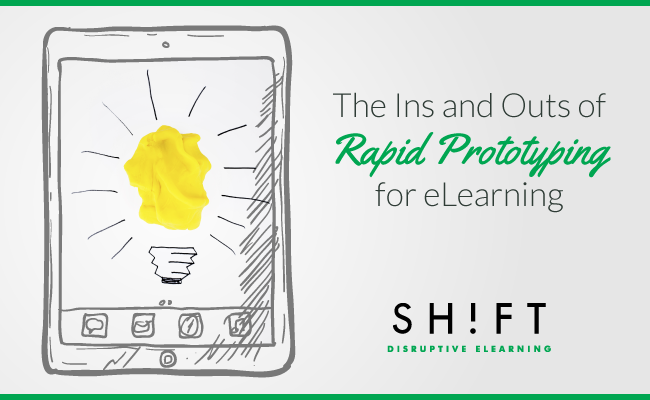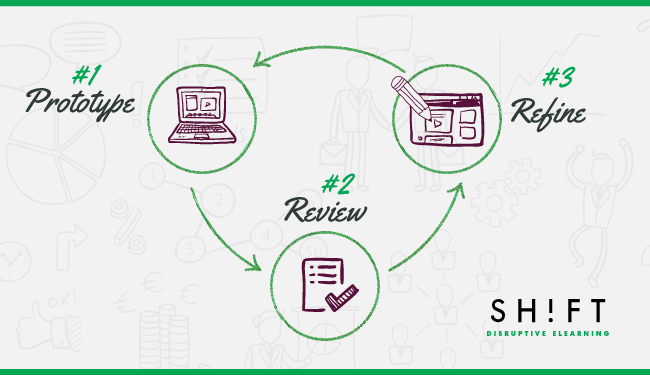There's you. Then there are the graphic designers, the coding guys, and the client. How do you ensure that you are all on the same page about the eLearning course that you are developing so painstakingly? How do you ensure that at the end of the developmental stage, your client does not come back perplexed with these words, "But I thought you were going to…?" These ominous words usually trigger a flurry of activity back at the drawing board. Efforts increase, costs escalate, and tempers are frayed (usually at the client's end).
How do you ensure that all stakeholders get a fair idea of how the eLearning course will turn out to be right at the outset, so you are spared the re-work? Do Rapid Prototyping.
Here's everything you need to know about it.

What is Rapid Prototyping?
Rapid Prototyping is an instructional design approach that combines the design, developmental, and evaluation phases. It is a non-linear approach that produces a sample working model that is a scaled-down representative version of the whole course.
A primary goal of the prototype is to provide a general understanding of how the course will look and work like. It is built to test the instructional efficacy and/or usability of concepts or processes like interactive activities and the navigational framework.
Rapid Prototyping overcomes the challenges of the conventional ADDIE practices by enabling stakeholders to peek into the course and provide feedback that the designers can implement without needing to worry about redoing the course.
What Are the Benefits of Rapid Prototyping?
Rapid Prototyping lets you create effective eLearning courses that address the needs of the learners in the most cost- and time-efficient manner. Other benefits we can mention:
- It encourages instructional designers to think out-of-the-box. Because Rapid Prototyping does away with the need for time-consuming and expensive reworks, designers feel confident about stepping outside their creativity confines to dream up innovative ways to present content. And now that you can be bold, you will discover that your creative juices flow more freely (and faster) when you tinker with the prototype.
- It enhances communication between different stakeholders. Because Rapid Prototyping juxtaposes the various stages of the course development process, many stakeholders find opportunities to connect with one another.
- It is flexible, fast, and effective. You don't have to worry about nailing it right or polishing it in the prototype stage. A prototype can be created in a jiffy. It takes even less time to make changes in a prototype.
- It establishes expectations early on in the project. Rapid prototyping lets clients preview the course very early on. This is your golden opportunity to validate assumptions and make sure your ideas meet client expectations. What is more, you can do all these without having to spend time and effort to create a fully-functional, polished product.
- It is a resource-efficient process. Put in just five minutes of your time to draw a quick sketch, and you can save hours of trial-and-error, hundreds of dollars worth of extra effort, and countless anxious moments towards the end stages of development. When you introduce a rapid prototyping round in the design and development stage, you can prevent wastage of effort.
When Should You Do Rapid Prototyping?
In eLearning, there is no one-size-fits-all theory of designing. According to Made Learning Designs rapid prototyping is the ideal solution in the following cases:
- When the course is complex or is laden with media: You may have been toying with storyboards since long, but not everybody can interpret media-heavy interactive activities from the pages of text in the storyboard. Your clients may not be eLearning experts. So spare them the ordeal of trying to figure out your ideas from storyboards. Rapid Prototyping will get the message across more effectively.
- When there are complex interactive activities in the course: Rapid Prototyping can also be done for selected sections of a course, say a complicated interactive activity. You may expend a lot of words to describe the activity, but some people may not be able to "visualize" it. In such cases, a prototype helps lend clarity to the activity.
- When the "look-and-feel" of the course is critical: If the look-and-feel of the course is critical, you need something more evocative than a storyboard to convey your ideas. Rapid Prototyping is the ideal solution in this case.
What is the Hallmark of an Effective Prototype?
- Perfectly imperfect: The effective prototype is "perfectly imperfect" according to TD experts. It is stripped of inessentials like color, text, and the perfect image. The prototype is crude, but it can be churned out in a short time. It focuses on conveying the design idea readily without cluttering the product with text and images.
- Quickly done: The effective prototype is easy to turn out. Without the need to hunt for that perfect image or write and rewrite countless times to find the most apt word, you can concentrate on expressing the functionality and usability of the course and get it done within a short time.
- Leaves room for failure: An effective prototype invites queries and challenging feedback. Questions like "Couldn't I have done this?" and feedback like, "This could have done in another way" indicate the prototype has succeeded in engaging the end-user. End-user feedback, queries, and recommendations help you design a meaningful course. Your prototype has gaps, but then this is what it was meant to be—a "perfectly imperfect" miniature rendition of your course.
Wrapping Up: How Should You Carry Out Prototyping?
As the moniker suggests, rapid prototype is nothing if it cannot be produced rapidly and at the least cost possible. After all, you will probably make more than one prototype.
Here's the conventional three-step process of creating an effective prototype:
- Creating the Prototype: This is the stage where your create the mock-ups based on the learning needs of your audience, the instructional strategy decided beforehand, and the technical scope of the project.
- Reviewing: This is the stage where your clients and/or the end-users step in to have the first peek. They review the prototype for functionality and usability. This stage comes quite early in the developmental phase.
- Refining: This is your chance to make slight tweaks or revamp the prototype to match the feedback and recommendations of the users.
Rapid Prototyping is a smart way of designing eLearning courses. Although it takes slightly more time and effort to create a prototype than to write a storyboard, the benefits and efficacy far outweigh the disadvantages.
Learn more about Rapid Protoyping for eLearning:
- Prototypes Are Essential to e-Learning Design
- 3 Rules of Rapid eLearning Prototyping
- 3 Levels of Instructional Design Prototypes
- Instructional Design and Rapid Prototyping: Rising from the Ashes of ADDIE
- Using Prototyping in Instructional Design (Book)
- Rapid prototype vs Storyboard
Sources:
Boulet, Guy. Rapid Prototyping: An efficient way to collaboratively design and develop e-learning content. (http://www.guyboulet.net/)
Tripp, Steven D. & Bichelmeyer, Barbara. (1990) Rapid Prototyping: An Alternative Instructional Design Strategy.









